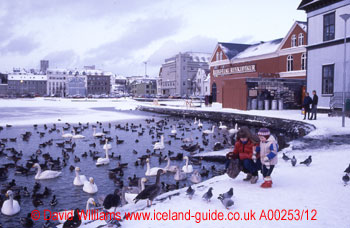 |
| To
the east of the lake of Mývatn lies a cold gravel desert. In
winter it becomes impassable except by snowmobiles. |
 |
| Reykjavík`s
little lake of Tjörnin has a corner kept ice-free during the
winter by natural hot water. Then it attracts many birds and locals
who come to feed them. |
Work stops
at midday on Christmas Eve and by 6pm the capital`s transport system has
come to a halt. Some people may go to a special church service on Christmas
Eve, but most families are making the final preparations for the first
of the festive meals.
The main meat is the hardy Icelandic sheep and a popular treat is hangikjöt
(strong-tasting smoked lamb); ptarmigan is also common. One interesting
delicacy is laufabraud
— paper-thin slices of decorated "lace bread" made from
a buttery dough that is deep-fried. To these foods, add a pile of potatoes,
tomatoes (grown in geothermally heated glasshouses), cakes, biscuits and
unlimited supplies of coffee and you start to build up the small mountain
of food needed for half a dozen festive meals over a three-day period.
The Icelanders always work hard at enjoying themselves! As the meal is
digested and the adults sit back, perhaps with a glass of Brennivín
(Icelandic schnapps) the children are allowed to open their presents.
Christmas Day and Boxing Day continue this essentially family-centred
tradition, with visits paid to nearby relatives. Inevitably, the tables
again groan under the weight of food that is prepared for yet another
feast. Those citizens of Reykjavík who want to walk off
the festive excesses may go to feed the birds at Tjörnin,
the city`s lake. This is normally frozen in the winter but natural hot
water flows into one corner, keeping it ice-free.
On December 27th the holiday ends, the traffic starts up and the tasks
of everyday life must be faced again. New Year celebrations, with fireworks
and perhaps a dance, are less than a week away, but there is still a long
way to go to the First Day of Summer (in the second half of April). By
then much of the snow has gone, the long days of darkness are forgotten
about and the summer`s activities start in earnest.
Back
to the list of articles about this country
|

